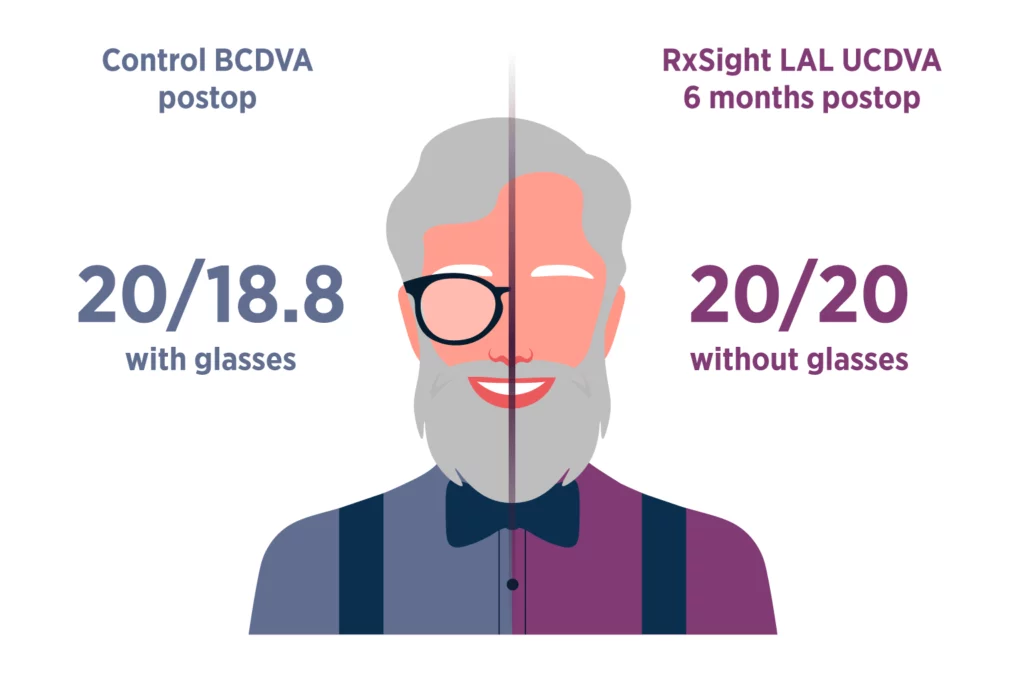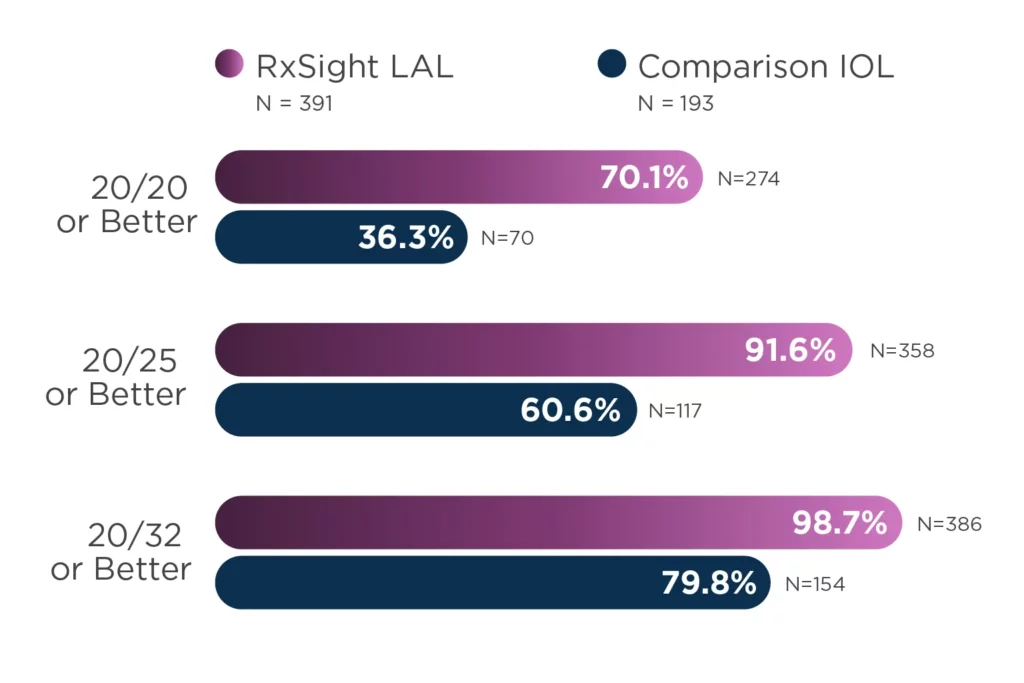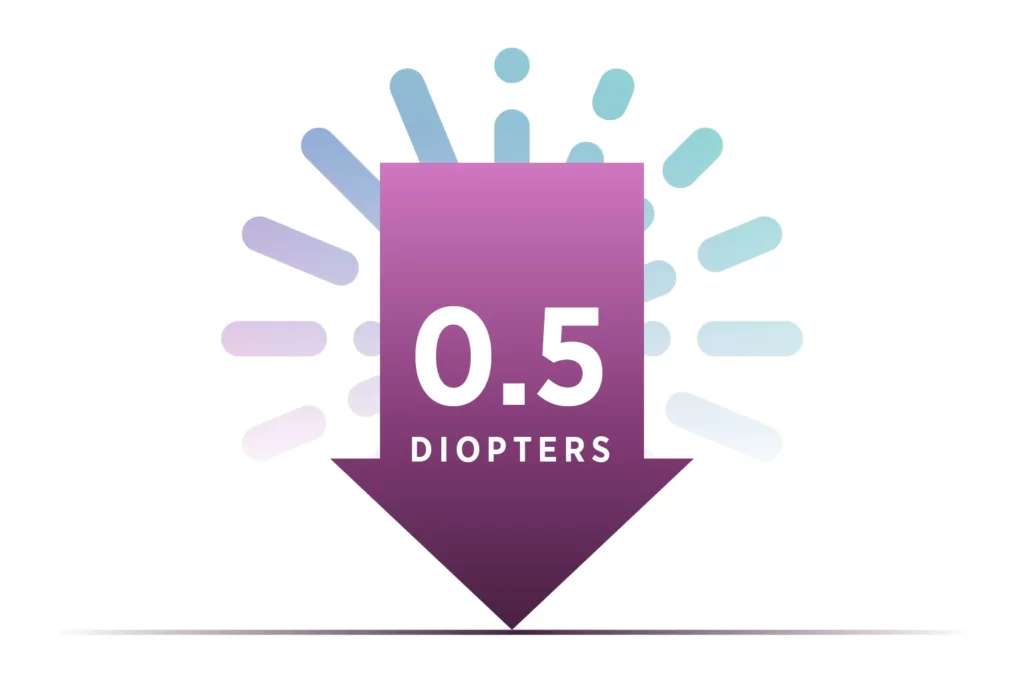The Light Adjustable Lens is made of a special photosensitive material that changes shape and power of the implanted lens in response to ultraviolet (UV) light. The light treatments are delivered by the RxSight® Light Delivery Device™ (LDD™), which are done in your eye doctor’s office. What makes the Light Adjustable Lens so unique is that these changes are made to the lens after it has been implanted in your eye and you have healed from surgery.
Please follow all instructions provided to you by your eye doctor and staff, including use of the UV-blocking glasses that will be provided to you. As with any cataract surgery, your vision may not be perfect after surgery. While your eye doctor selected the lens they anticipated would give you the best possible vision, it was only an estimate. Fortunately, you have selected the Light Adjustable Lens! In the following weeks, you and your eye doctor will work together to optimize your vision. Please make sure to pay close attention to your vision and be prepared to discuss preferences with your eye doctor.
The UV-blocking glasses provided to you protect the Light Adjustable Lens from UV light sources other than the LDD that your eye doctor will use to optimize your vision. Exposing the Light Adjustable Lens to other UV light sources can potentially change the lens correction in an uncontrolled manner. If you do not wear the provided UV-blocking glasses, your vision may not improve or it could get worse. If this happens, please contact your eye doctor.
The UV-blocking glasses should be worn at all times until your eye doctor tells you that you no longer need to wear them (usually 24 hours after your final light treatment). Total wear is typically about 4 to 5 weeks in duration, however, this may vary depending on the number of light treatments delivered.
No. You should wear the UV-blocking glasses provided to you. These glasses have a special protective coating that no other glasses have.
Please notify your eye doctor/clinic as soon as possible if one of your two pairs of UV-blocking glasses are lost, damaged, or unwearable, and then continue to wear the other pair. If both pairs are lost or damaged, wear the darkest sunglasses you have and contact your eye doctor/clinic.
Showering
If there is a window or possible direct sunlight in your shower, please wear the UV-blocking glasses in the shower or consider showering after the sun has gone down or before it comes up. If there is no direct sunlight, you do not need to wear your UV-blocking glasses when you shower. However, please put them on immediately afterwards.
Sports
Your eye doctor will advise you when you can return to sports. Your return to more impactful activities may need to be delayed until all light treatments are complete to guarantee a stable Light Adjustable Lens for light treatments.
Tanning Studio
A tanning studio bed is a very strong source of UV light and should be avoided until all light treatments are complete and you have been advised that you can remove your UV-blocking glasses.
Makeup
Your eye doctor will advise you when you can return to wearing eye makeup. Be careful when removing eye makeup and do not place excessive pressure on the eye. Permanent makeup should be delayed until the eye is considered fully healed by your eye doctor.
Travel
Travel is not impacted. Be sure to bring all of your UV-blocking glasses with you. Be particularly diligent in protecting your eyes from UV sources in unfamiliar environments.
Work
Work is not impacted, unless your profession puts you at a higher risk of UV exposure. Please remember to wear your UV-blocking glasses at work until you are told by your eye doctor that it is no longer necessary.
Laser Treatments
It is recommended that you wait until all light treatments are complete and you have been advised that you can remove your UV-blocking glasses before proceeding with hair removal (IPL) treatments (different IPL devices use different wavelengths). This includes other facial beauty treatments that use light sources.
It is very important that you do not forget to wear your UV-blocking glasses. However, if you do forget, please put them on as soon as you remember.
Between 1 and 3 light treatments, each lasting approximately 90 seconds and separated by approximately 3 days, are required. The total number of light treatments is based on achievement of the desired visual outcome that you and your eye doctor selected. Once you have achieved your final optimal vision, the lens power is permanently locked with 2 final light treatments to prevent any further changes.
Numbing drops will be applied to your eye. There may be some mild pressure or discomfort, and some patients have perceived the treatment to be bright; however, the light treatments should not be painful.
Your vision may be blurry immediately after each treatment due to a gel used during application of the light treatment, but this should resolve quickly. Additionally, your eye may be dilated for the treatment, which may require wearing the tinted UV-blocking glasses for a few hours. It may take approximately 24 hours after each light treatment to notice an improvement in your vision. The light from the LDD may also cause a temporary or long-lasting pink or red afterimage. This tinge to your vision is especially noticeable on things that normally look white, but should resolve before your next light treatment. Speak with your eye doctor if the pink or red afterimage remains.
The unique feature of the Light Adjustable Lens is that the refractive power can be changed after implantation in the eye using a clinic-based UV light source called a Light Delivery Device™ (LDD™). The Light Adjustable Lens contains photosensitive macromers distributed throughout the lens. When ultraviolet (UV) light from the LDD is directed to a specific area of the lens, the macromers in the path of the light polymerize with other macromers. The remaining unpolymerized macromers then move to the light-exposed area. This movement causes a highly predictable change in the curvature of the lens. The new shape of the lens represents the refraction entered into the LDD.
Patients must follow all instructions provided by their cataract surgeon, including use of the UV-blocking glasses provided to them at the conclusion of surgery. As with any cataract procedure, the patient’s vision may not be perfect after surgery. Fortunately, these patients have selected the Light Adjustable Lens. Over the next few weeks, the patient and their eye doctor(s) will work together to optimize their vision.
The RxSight® UV-blocking glasses that patients are provided protect the Light Adjustable Lens from UV light sources other than the LDD that their cataract surgeon uses to optimize their vision. Exposing the Light Adjustable Lens to other UV light sources could potentially lead to uncontrolled refractive changes. If this happens, the patient should be advised to contact their cataract surgeon.
The Light Adjustable Lens also offers an additional layer of protection from incidental UV exposure beyond the UV glasses alone called ActivShield™. ActivShield is a revolutionary UV protective layer built into the Light Adjustable Lens to help protect the lens until treatments are complete.
The UV-blocking glasses should be worn until their cataract surgeon tells them that they no longer need to wear them (usually 24 hours after their final light treatment). Total wear is typically about 4 to 5 weeks in duration, however, this may vary depending on the number of light treatments delivered.
The patient should only remove their UV-blocking glasses when absolutely necessary, and it is recommended they continue wear immediately after each test is complete. All in-office ophthalmic testing and examination can be performed.
If you are providing a refractive result to the patient’s cataract surgeon for use in LDD treatment, please remember that this is the correction the patient will receive to the Light Adjustable Lens. Unlike spectacles and contact lenses, the correction cannot be changed once locked in. Providing an accurate refraction, as well as offering any feedback on the patient’s preferences and goals, can be incredibly valuable to the cataract surgeon in providing the patient with their best possible vision. We recommend checking vision and performing refraction with the lights ON to ensure the most accurate refraction is found. We offer a refraction calculator to aid in verifying the accuracy of refraction.
No. They should wear the UV-blocking glasses provided to them by their doctor. These glasses have a special protective coating that no other glasses have, to ensure the Light Adjustable Lens is protected from incidental UV exposure.
They should notify their cataract surgeon as soon as possible if one of the two pairs of UV-blocking glasses are lost, damaged or unwearable, and then continue to wear the other pair. If both pairs are lost or damaged, they should wear the darkest sunglasses they have and a peaked hat and contact their cataract surgeon.
Showering
If there is a window or possible direct sunlight in their shower, they should wear their UV-blocking glasses or consider showering after the sun has gone down or before it comes up. If there is no direct sunlight, they do not need to wear the UV-blocking glasses. However, they should put them on afterwards.
Sports
The patient’s cataract surgeon will advise them when they can return to sports. The patient’s return to more impactful activities may need to be delayed until all light treatments are complete to guarantee a stable Light Adjustable Lens for light treatments.
Tanning Studio
A tanning studio bed is a very strong source of UV light and should be avoided until all light treatments are complete and the patient has been advised that they can remove their UV-blocking glasses.
Makeup
The patient’s cataract surgeon will advise them when they can return to wearing eye makeup. Patients must be careful when removing eye makeup and should not place excessive pressure on the eye. Permanent makeup should be delayed until the eye is considered fully healed.
Travel
Travel is not impacted. Patients should remember to bring all of their UV-blocking glasses with them. They should be particularly diligent in protecting their eyes from UV sources in unfamiliar environments.
Work
Work is generally not impacted, unless their profession puts them at a higher risk of UV exposure. They should remember to wear their UV-blocking glasses at work until they are told by their cataract surgeon that it is no longer necessary.
Laser Treatments
Laser devices that expose patients to UV light are routinely used as diagnostic, therapeutic, or cosmetic tools. Wavelength and amount of energy utilized by the device are important to know in order to assess the risk to Light Adjustable Lens patients who have not yet received their complete lock-in treatments. While the Light Adjustable Lens is safe to undergo nearly all ophthalmic testing and procedures before lock-in is complete without the risk of incidental UV exposure, please consult with your RxSight Clinical Affairs Training Specialist should you require additional information for your assessment.
It is recommended that the UV-blocking glasses are worn all waking hours. However, if they do forget, they should put them on as soon as they remember. They should note how long they were without the glasses and the light conditions during that time and contact their cataract surgeon.
The lens can be adjusted 1 to 3 times, but the total number of light treatments is based on achievement of the desired visual outcome determined by the surgeon and patient. Once adjustments are complete, the lens power is permanently locked-in with 2 final light treatments to prevent any further changes.
Each light treatment will last between 8 and 120 seconds, with the average being approximately 90 seconds. Variation in time is dependent on the type of treatment performed. The light treatment uses a coupling gel and contact lens to focus the UV light onto the Light Adjustable Lens (for the patient, it will be very similar to a gonioscopy examination).
Their vision may be blurry immediately after each treatment due to the coupling gel used with the contact lens during application of the light treatment, but this should resolve quickly. Additionally, their eye will be dilated for the treatment, which may cause blurred vision and increase light sensitivity—the tinted UV-blocking glasses may be more comfortable during this time. It may take approximately 24 hours after each light treatment for the patient to notice an improvement in their vision. The light from the LDD may also cause a temporary pink or red tinge to their vision that is especially noticeable on things that normally look white. For more information, please see the RxSight Patient Information Brochure, which is available in our resource library.
Approved use: The Light Adjustable Lens™ (LAL®), Light Adjustable Lens+™ (LAL+™), and Light Delivery Device™ (LDD™) system is approved for patients who have a cataract and need surgery for it, have corneal astigmatism (at least 0.75 diopters) before surgery, and do not have preexisting macular disease.
Who should not receive this treatment? The LAL/LAL+ and LDD system should not be used if you are taking medications that may increase your sensitivity to ultraviolet (UV) light; if you are taking a medication that is considered harmful to your retina; if you have a history of herpes eye infection or uncontrollable eye movements (nystagmus); or if you are unable to comply with your doctor’s schedule of LDD light treatments and instructions for wearing special UV-protective glasses for several weeks following cataract surgery.
What warnings should I be aware of? Preexisting macular disease and certain eye conditions may increase the risk of complications. Your doctor will determine if you are a good candidate for the LAL/LAL+. If you have any complications during your cataract surgery before the LAL/LAL+ is implanted, you may need to have another intraocular lens (IOL) implanted instead of the LAL/LAL+.
What precautions should I be aware of? The safety and effectiveness of the LAL and LDD have not been established in patients with certain preexisting eye conditions or in patients who experience certain complications during cataract surgery. The safety and effectiveness of the LAL+ has not been substantiated in clinical trials. The effect of the LAL+ optical design on quality of vision, contrast sensitivity, and subjective visual disturbances have not been evaluated clinically. You should discuss these issues with your doctor.
Following surgery, you must wear the special UV-protective glasses during all waking hours for about 4 to 5 weeks and comply with your doctor’s schedule of LDD light treatments. Failure to wear the UV-protective glasses can result in an unpredicted vision change or loss of vision quality after exposure to UV light, such as from sunlight. This may require a second surgery to remove the LAL/LAL+ from your eye and replace it with another IOL.
What are the potential risks? As with any surgical procedure, there are risks associated with cataract surgery and IOL implantation. Please discuss these risks with your doctor. Potential risks associated with LDD light treatments include mild alterations to color perceptions; temporary scratchiness, irritation, or dryness to the front part of your eye; and activation of a previously undiagnosed herpes eye infection. Longer lasting and serious adverse events related to the UV light exposure are possible, but rare. There is a small chance that your vision could be made worse or that you may require additional surgery as a result of a complication.
Caution: Federal law restricts this device to sale by or on the order of a physician.
©2024 RxSIGHT. All Rights Reserved. COM-1043 Rev. C

The LAL provides optimized vision for patient satisfaction.2
LAL patients saw nearly as well without glasses (UCDVA) as control patients did with glasses (BCDVA).
Since the LAL is a monofocal lens, there is low risk of dysphotopsias caused by splitting light, leading to potentially enhanced vision and patient satisfaction.

The LAL offers LASIK-like accuracy in cataract surgery.2,3
92% of eyes (N = 391) achieved results within 0.50 D of target manifest refraction spherical equivalent (MRSE).
Patients are approximately two times more likely to achieve 20/20 vision or better without glasses at 6 months.
The study was a prospective, controlled, multicenter, 12-month study of 600 patients (ITT population) randomized to receive implantation with the RxSight LAL (N = 403) or a commercially available monofocal IOL (N = 197). Effectiveness analyses included 391 LAL patients and 193 control patients. Primary safety variables included best spectacle-corrected visual acuity (BSCVA) at 6 months and incidence of sight-threatening complications and adverse events. Primary effectiveness variables included percent reduction in manifest cylinder at 6 months, percent mean absolute reduction in MRSE at 6 months, and rotation of meridian of LAL at 6 months. Percent of eyes with an uncorrected visual acuity (UCVA) of 20/20 or better at six months post-operatively compared between the LAL treatment group and the monofocal control group was a secondary endpoint.

The Light Adjustable Lens corrects down to 0.5 diopters of astigmatism, which is the lowest level approved to be treated.